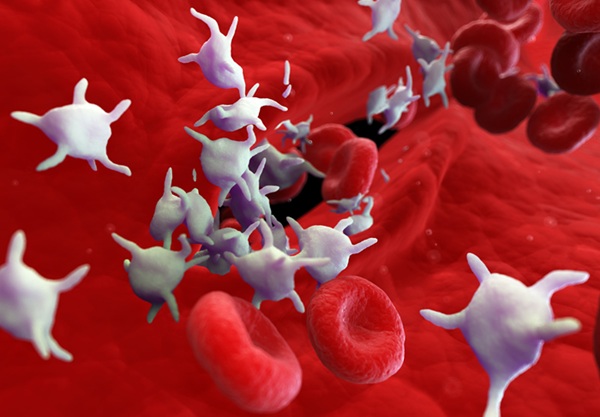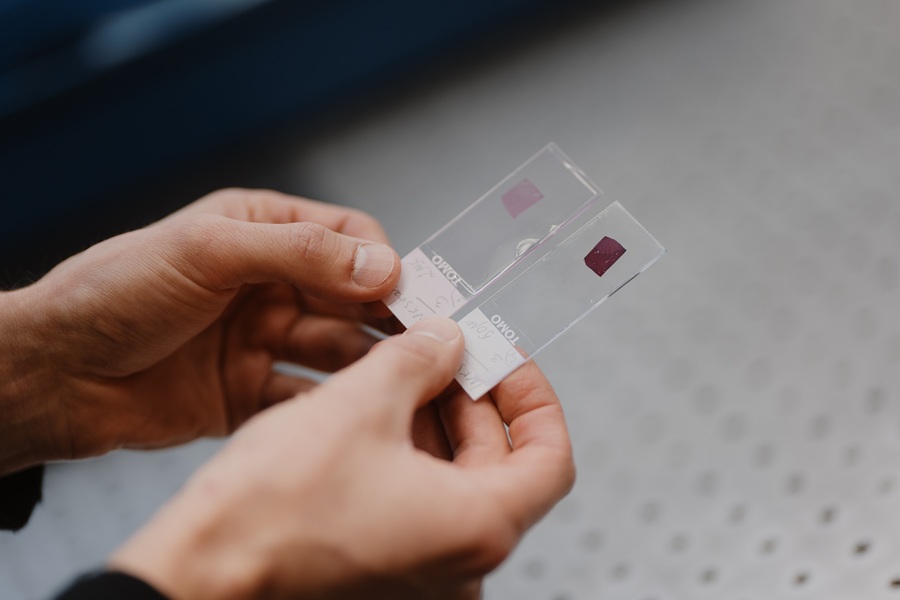Immune Signature Predicts Asthma Susceptibility
|
By LabMedica International staff writers Posted on 27 Feb 2018 |

Image: The frequency and activity of conventional T cells serves as an early childhood immune signature that predicts the development of asthma later on. The iNKT cells are shown in green, lung vasculature in red and cell nuclei in blue (Photo courtesy of Dr. Catherine Crosby, La Jolla Institute for Allergy and Immunology).
Asthma is a chronic inflammatory disease driven by the interplay of genetics, environmental factors and a diverse cast of immune cells. A subset of T cells has been identified whose frequency serves as early childhood immune signature that predicts the risk of developing asthma later on.
Consistent with the "hygiene hypothesis," which holds that increased microbial exposure in the first years of life is protective for asthma, the new findings also indicate that the presence of house dust components that stimulate the innate immune system decreases asthma risk.
Scientists at La Jolla Institute for Allergy and Immunology (La Jolla, CA, USA) followed 560 families from four disadvantaged urban areas who are at high risk for asthma to uncover potential risk factors that contribute to increased asthma rate in children growing up in impoverished neighborhoods. The team analyzed the frequency of different types of immune cells in blood collected from 110 one year-old study participants, the presence of immune-stimulatory components in the subjects' house dust and asked whether any of the factors correlated with an increase of asthma at age seven.
The team used peripheral blood from the participants to determine determined whether invariant natural killer T-cells (iNKT) or mucosal-associated invariant T-cells (MAIT) cell frequency at one year is correlated with the cytokine polarization of mainstream CD4+ T cells and/or the development of asthma by age seven years. Unlike conventional T cells, which belong to the adaptive arm of the immune response and take a few days before they are fully trained on a single, specific protein fragment or peptide antigen, MAIT and iNKT cells recognize molecular components common to many microbes. In addition dust samples from 300 houses were tested for iNKT cell antigenic activity.
The investigators showed that a higher MAIT cell frequency at one year of age was associated with a decreased risk of asthma by age seven years. The frequency of MAIT cells was associated with increased production of interferon-gamma (IFN-γ) by activated CD4+ T cells from the cohort. The iNKT cell antigenic activity in bedroom dust samples was associated with higher endotoxin concentration and also with reduced risk of asthma.
Mitchell Kronenberg, PhD, president and chief scientific officer of La Jolla Institute and senior author of the study, said, “We found what I would consider very strong biomarkers for those children who are most likely to develop asthma as they get older. Children who, at the age of one, had a higher frequency of so called MAIT cells appear to be less likely to develop asthma by the age of seven.” The study was published on February 5, 2018, in the Journal of Immunology.
Related Links:
La Jolla Institute for Allergy and Immunology
Consistent with the "hygiene hypothesis," which holds that increased microbial exposure in the first years of life is protective for asthma, the new findings also indicate that the presence of house dust components that stimulate the innate immune system decreases asthma risk.
Scientists at La Jolla Institute for Allergy and Immunology (La Jolla, CA, USA) followed 560 families from four disadvantaged urban areas who are at high risk for asthma to uncover potential risk factors that contribute to increased asthma rate in children growing up in impoverished neighborhoods. The team analyzed the frequency of different types of immune cells in blood collected from 110 one year-old study participants, the presence of immune-stimulatory components in the subjects' house dust and asked whether any of the factors correlated with an increase of asthma at age seven.
The team used peripheral blood from the participants to determine determined whether invariant natural killer T-cells (iNKT) or mucosal-associated invariant T-cells (MAIT) cell frequency at one year is correlated with the cytokine polarization of mainstream CD4+ T cells and/or the development of asthma by age seven years. Unlike conventional T cells, which belong to the adaptive arm of the immune response and take a few days before they are fully trained on a single, specific protein fragment or peptide antigen, MAIT and iNKT cells recognize molecular components common to many microbes. In addition dust samples from 300 houses were tested for iNKT cell antigenic activity.
The investigators showed that a higher MAIT cell frequency at one year of age was associated with a decreased risk of asthma by age seven years. The frequency of MAIT cells was associated with increased production of interferon-gamma (IFN-γ) by activated CD4+ T cells from the cohort. The iNKT cell antigenic activity in bedroom dust samples was associated with higher endotoxin concentration and also with reduced risk of asthma.
Mitchell Kronenberg, PhD, president and chief scientific officer of La Jolla Institute and senior author of the study, said, “We found what I would consider very strong biomarkers for those children who are most likely to develop asthma as they get older. Children who, at the age of one, had a higher frequency of so called MAIT cells appear to be less likely to develop asthma by the age of seven.” The study was published on February 5, 2018, in the Journal of Immunology.
Related Links:
La Jolla Institute for Allergy and Immunology
Latest Immunology News
- Stem Cell Test Predicts Treatment Outcome for Patients with Platinum-Resistant Ovarian Cancer
- Machine Learning-Enabled Blood Test Predicts Immunotherapy Response in Lymphoma Patients
- Post-Treatment Blood Test Could Inform Future Cancer Therapy Decisions
- Cerebrospinal Fluid Test Predicts Dangerous Side Effect of Cancer Treatment
- New Test Measures Preterm Infant Immunity Using Only Two Drops of Blood
- Simple Blood Test Could Help Choose Better Treatments for Patients with Recurrent Endometrial Cancer
- Novel Analytical Method Tracks Progression of Autoimmune Diseases
- 3D Bioprinted Gastric Cancer Model Uses Patient-Derived Tissue Fragments to Predict Drug Response
- Blood Test for Fungal Infections Could End Invasive Tissue Biopsies
- Cutting-Edge Microscopy Technology Enables Tailored Rheumatology Therapies
- New Discovery in Blood Immune Cells Paves Way for Parkinson's Disease Diagnostic Test
- AI Tool Uses Routine Blood Tests to Predict Immunotherapy Response for Various Cancers
- Blood Test Can Predict How Long Vaccine Immunity Will Last
- Microfluidic Chip-Based Device to Measure Viral Immunity
- Simple Blood Test Could Detect Drug Resistance in Ovarian Cancer Patients
Channels
Clinical Chemistry
view channel
Carbon Nanotubes Help Build Highly Accurate Sensors for Continuous Health Monitoring
Current sensors can measure various health indicators, such as blood glucose levels, in the body. However, there is a need to develop more accurate and sensitive sensor materials that can detect lower... Read more
Paper-Based Device Boosts HIV Test Accuracy from Dried Blood Samples
In regions where access to clinics for routine blood tests presents financial and logistical obstacles, HIV patients are increasingly able to collect and send a drop of blood using paper-based devices... Read moreMolecular Diagnostics
view channel
RNA-Based Blood Test Detects Preeclampsia Risk Months Before Symptoms
Preeclampsia remains a major cause of maternal morbidity and mortality, as well as preterm births. Despite current guidelines that aim to identify pregnant women at increased risk of preeclampsia using... Read more
First Of Its Kind Test Uses microRNAs to Predict Toxicity from Cancer Therapy
Many men with early-stage prostate cancer receive stereotactic body radiotherapy (SBRT), a highly precise form of radiation treatment that is completed in just five sessions. Compared to traditional radiation,... Read moreNovel Cell-Based Assay Provides Sensitive and Specific Autoantibody Detection in Demyelination
Anti-myelin-associated glycoprotein (MAG) antibodies serve as markers for an autoimmune demyelinating disorder that affects the peripheral nervous system, leading to sensory impairment. Anti-MAG-IgM antibodies... Read moreHematology
view channel
New Scoring System Predicts Risk of Developing Cancer from Common Blood Disorder
Clonal cytopenia of undetermined significance (CCUS) is a blood disorder commonly found in older adults, characterized by mutations in blood cells and a low blood count, but without any obvious cause or... Read more
Non-Invasive Prenatal Test for Fetal RhD Status Demonstrates 100% Accuracy
In the United States, approximately 15% of pregnant individuals are RhD-negative. However, in about 40% of these cases, the fetus is also RhD-negative, making the administration of RhoGAM unnecessary.... Read moreMicrobiology
view channel
Handheld Device Deliver Low-Cost TB Results in Less Than One Hour
Tuberculosis (TB) remains the deadliest infectious disease globally, affecting an estimated 10 million people annually. In 2021, about 4.2 million TB cases went undiagnosed or unreported, mainly due to... Read more
New AI-Based Method Improves Diagnosis of Drug-Resistant Infections
Drug-resistant infections, particularly those caused by deadly bacteria like tuberculosis and staphylococcus, are rapidly emerging as a global health emergency. These infections are more difficult to treat,... Read more
Breakthrough Diagnostic Technology Identifies Bacterial Infections with Almost 100% Accuracy within Three Hours
Rapid and precise identification of pathogenic microbes in patient samples is essential for the effective treatment of acute infectious diseases, such as sepsis. The fluorescence in situ hybridization... Read morePathology
view channel
Advanced Imaging Reveals Mechanisms Causing Autoimmune Disease
Myasthenia gravis, an autoimmune disease, leads to muscle weakness that can affect a range of muscles, including those needed for basic actions like blinking, smiling, or moving. Researchers have long... Read more
AI Model Effectively Predicts Patient Outcomes in Common Lung Cancer Type
Lung adenocarcinoma, the most common form of non-small cell lung cancer (NSCLC), typically adopts one of six distinct growth patterns, often combining multiple patterns within a single tumor.... Read moreTechnology
view channel
Pain-On-A-Chip Microfluidic Device Determines Types of Chronic Pain from Blood Samples
Chronic pain is a widespread condition that remains difficult to manage, and existing clinical methods for its treatment rely largely on self-reporting, which can be subjective and especially problematic... Read more
Innovative, Label-Free Ratiometric Fluorosensor Enables More Sensitive Viral RNA Detection
Viruses present a major global health risk, as demonstrated by recent pandemics, making early detection and identification essential for preventing new outbreaks. While traditional detection methods are... Read moreIndustry
view channel
Cepheid and Oxford Nanopore Technologies Partner on Advancing Automated Sequencing-Based Solutions
Cepheid (Sunnyvale, CA, USA), a leading molecular diagnostics company, and Oxford Nanopore Technologies (Oxford, UK), the company behind a new generation of sequencing-based molecular analysis technologies,... Read more
Grifols and Tecan’s IBL Collaborate on Advanced Biomarker Panels
Grifols (Barcelona, Spain), one of the world’s leading producers of plasma-derived medicines and innovative diagnostic solutions, is expanding its offer in clinical diagnostics through a strategic partnership... Read more









.jpg)












